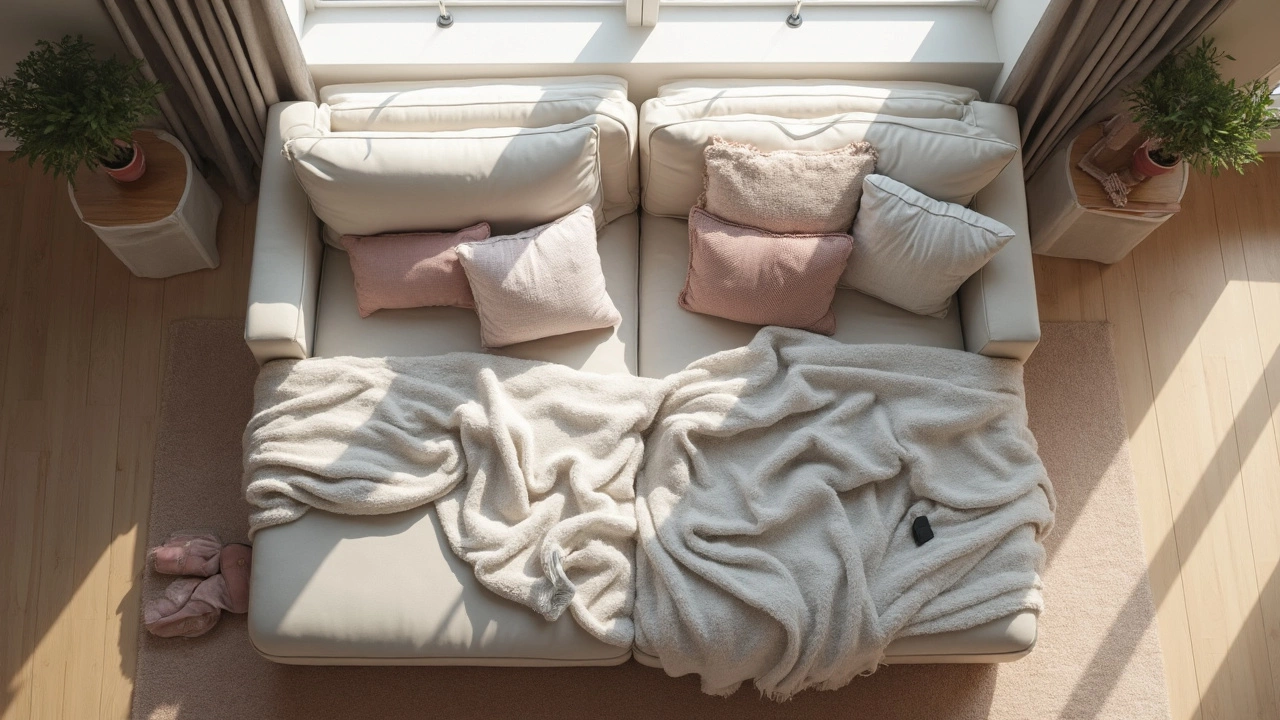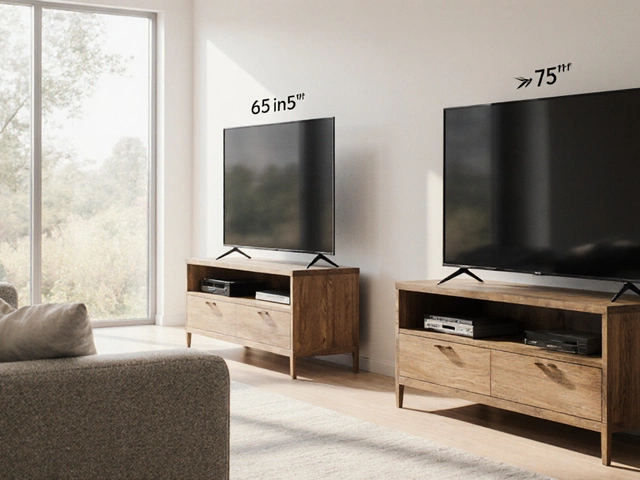No one wants to wake up with a sore back or sweat through a night on a lumpy bed. The comfort level of a futon or sofa bed can seriously change how much you enjoy your living space—or regret that last-minute purchase.
So, how do you really compare them? Futons tend to have thinner mattresses and a firmer feel. They're often seen in college apartments and home offices for a reason: they're easy to move, but rarely feel like a luxury mattress. Sofa beds look more like a regular couch. Most have thicker seat cushions and a hidden mattress underneath. At first glance, this sounds great, but not all sofa beds are made equal—some hide thin, squeaky mattresses that fold up awkwardly.
Instead of guessing, you want to know how these options actually hold up for sleeping, sitting, and the long haul. There are a few tricks to measure true comfort, and a couple of myths people still believe about what's best for guests or everyday use.
- What Makes a Futon Comfortable?
- The Real Comfort Level of Sofa Beds
- Key Differences: Sleeping vs. Sitting
- Tips to Improve Either Option
- What to Consider Before You Buy
What Makes a Futon Comfortable?
Let’s be honest: not all futons give you a good night’s sleep. The main thing that decides comfort is the mattress. Most futons use a cotton or foam mattress that’s thinner than what you’d find on a regular bed. If you pick a thick, high-density futon mattress, you’ll notice a huge difference versus the basic versions. Mattresses that are 8" thick or more tend to feel much better on your back and joints, especially if you sleep in one spot all night.
The frame matters too. A cheap metal frame usually means you’ll feel the bars under you—no fun if you’re a side sleeper. Wood frames, especially those with slats closer together, do a better job keeping things sturdy and flat. Some even have adjustable backs, so you can set angles for lounging or sleeping.
- Futons are often lighter than sofa beds, making them easy to move around for cleaning or rearranging.
- Most modern futon mattresses last 5-7 years if rotated regularly, according to real-world reports.
- If you go with a futon, a mattress topper can make a thin mattress much more bearable, especially for guests.
| Aspect | More Comfortable | Less Comfortable |
|---|---|---|
| Mattress Thickness | 8" or thicker | 4" to 6" |
| Frame Type | Wood with close slats | Metal bars, wide gaps |
| Mattress Material | High density foam or memory foam | Basic cotton |
A lot of people skip the cheap starter futons, knowing they sag or lump after a year. Spend a bit more on the mattress and frame, and you’ll get a setup that works for both everyday sitting and actual sleep. If you hate the feeling of hard bars or lumps, stay clear of the budget models. Also, keep in mind: futons are low to the ground, so older guests or people with knee issues might find them tricky to get up from.
The Real Comfort Level of Sofa Beds
Most people expect a sofa bed to feel like a real couch by day and a decent bed at night. That’s not always how it goes. Whether you’re picking a model with a spring mattress, memory foam, or even an air layer, each type has its own feel. The classic coil-and-bar style still shows up in budget sofa beds, but if you’ve spent a night wrestling with that metal bar in your back, you know how rough it can be.
More recent sofa beds often ditch the old bar-in-the-back problem by using memory foam mattresses or updated mechanisms, but even these improvements aren’t perfect. Memory foam stacks up better for overnight guests (and your back) but can still get hot or start to sag after a couple of years. If you want to use your sofa bed all the time, check the mattress thickness first. Most decent ones now range between 4 to 6 inches, though the sweet spot seems to be about 5 inches for most people.
The support structure matters just as much as the mattress. Cheap models might feel good as a couch, but turn into torture devices once they’re opened up. Some frames bend over time, especially if heavy people sleep on them a lot. That’s why weight limits matter; you’ll find most average sofa beds rated for around 250 lbs per sleeper, but higher-end frames can handle close to 400 lbs.
Here’s a quick look at how different types of sofa beds compare when it comes to comfort, based on user reviews and recent product tests:
| Type of Sofa Bed | Average Mattress Thickness | Best For | Common Complaints |
|---|---|---|---|
| Traditional Coil | 3-4 inches | Occasional Use | Lumpy, metal bar sensation |
| Memory Foam | 4-6 inches | Regular Guests | Gets hot, can sag over time |
| Air + Foam Hybrid | 4-5 inches | Short-term Stays | Leaks, needs regular refilling |
If you want your sofa bed to double as your main bed, it's smart to splurge on a model with a solid memory foam or latex mattress. Make sure to try it out in person, if you can. And don’t overlook little upgrades—adding a mattress topper or swapping out a flimsy support board can turn a mediocre sleeper into something you'll actually look forward to using.

Key Differences: Sleeping vs. Sitting
Here’s where things get real: futons and sofa beds feel totally different, whether you’re just hanging out or actually trying to get a decent night's sleep. Most people don’t realize how much this affects daily use until you’ve spent a few hours—or worse, a whole night—on one. Let’s break down where each shines (and where you might end up disappointed).
For sitting, sofa beds usually have the advantage. They’re designed to be real couches first, so you get deeper seat cushions, armrests, and better back support. You can binge Netflix or chat for hours without that sinking feeling you get from a flimsy futon. In comparison, futons tend to have a flat, firm seat that can get uncomfortable after a while. The backrest is often upright and not really made for lounging.
But when it’s time to actually lie down, the tables turn a bit. Most futons unfold into a flat surface, so you don’t get those annoying bars or gaps you sometimes find in old-school sofa beds. Still, futon mattresses are usually thin and can feel hard, especially on solid frames. On the other hand, the pull-out mattress in a sofa bed can be soft but often has metal bars or creases right where your back lands. According to a 2023 survey by the Sleep Foundation, 65% of sofa bed users complained about feeling the mattress mechanism through the bedding, while just 42% of futon users said comfort was an issue.
| Sofa Bed | Futon | |
|---|---|---|
| Best for Sitting? | ✔️ | ❌ |
| Best for Sleeping? | ❌/Depends on type | ✔️/If you like firmness |
| Typical Mattress Thickness | 3"-5" (pull-out) | 4"-8" (varies) |
| Common Pain Points | Bars & creases | Firmness/thinness |
One more thing: your body type and needs matter. If you’re a back or stomach sleeper, a futon's firmness might help. If you’re side-sleeping, the extra padding of a quality sofa bed is usually comfier—if it doesn't have that annoying bar down the middle.
If you want to boost comfort for either, try adding a mattress topper or extra cushioning. But don’t just trust the salesperson—always test out the exact futon or sofa bed floor model if you can. Your spine will thank you later.
Tips to Improve Either Option
Most futons and sofa beds can go from uncomfortable to decent with the right tweaks. You don’t have to settle for restless nights or awkward seats. Here’s how you can bump up the comfort factor—so guests won’t dread staying over, and you won’t dread the sofa bed yourself.
- Add a Mattress Topper. This is one of the easiest fixes. A 2-3 inch memory foam topper works wonders, especially for futons with firm or thin mattresses and sofa beds with those classic metal bars underneath. It’s easy to roll up and store, too.
- Check the Support Structure. For sofa beds, try laying a piece of plywood between the base and the mattress to cut down on sagging. For futons, check if the slats are evenly spaced; if not, add support slats or boards to prevent weird pressure points.
- Softer Sheets and Covers. Using good-quality, soft sheets and a mattress protector helps a lot. Cotton or bamboo feel best against the skin and breathe better, which is key if the mattress isn’t very thick.
- Pillow Up. Sometimes, a lack of support for your head, neck, or lower back ruins everything. Use firmer pillows, or double up regular ones. You can also tuck rolled towels under the knees or behind your lower back.
- Rotate and Air Out. Futon mattresses especially get lumpy over time. Rotate them every few weeks and, if possible, air them out in the sun. This keeps them from getting musty and helps them last longer.
It’s wild, but according to a consumer home study from 2023, about 61% of people said adding a mattress topper instantly made their sofa bed or futon usable for overnight guests. Just this small upgrade can mean the difference between a good night’s sleep and tossing all night. Here’s a quick rundown of what helps most:
| Upgrade | Best For | Common Price Range |
|---|---|---|
| Mattress Topper | Both | $40-120 |
| Plywood Support | Sofa Bed | $20-50 |
| Fresh Sheets | Both | $25-80 |
| Pillow Upgrades | Both | $20-60 |
If you’re serious about comfort, a little investment goes a long way. Instead of splurging on a whole new piece, start with one or two of these tricks. The difference is night and day—literally.

What to Consider Before You Buy
Picking between a futon and a sofa bed takes more than just sitting on one for two minutes in a store. How you actually plan to use it matters a lot. Are you hosting guests more often, or is this your daily crash zone? Thinking this through helps you pick a winner.
If your main goal is sleep, take a hard look at mattress thickness and material. A futon's pad might only be 4 to 6 inches thick, usually filled with cotton or foam. Sofa beds tend to use a fold-out mattress, with options ranging from a 3-inch foam slab to a legit 5-inch memory foam upgrade. If you see wire bars or super-thin cushions, that’s a red flag for back pain.
- Comfort test: Sit and lie down the way you actually would at home. Don’t just perch on the edge.
- Check if the cover is removable and washable. Spills and dust happen, especially in shared spaces.
- Size matters—twin, full, or queen? Measure your space and leave room to open out the bed fully. It’s easy to forget until the first time you bump into your coffee table at midnight.
- Weight and moving: Some sofa beds are shockingly heavy. If you move apartments a lot, a futon is way easier to handle.
- Look for solid frames. Cheap metal futons bend fast. Hardwood frames on either option last longer.
Here's a side-by-side look at some useful numbers to have on hand:
| Feature | Futon | Sofa Bed |
|---|---|---|
| Typical Mattress Thickness | 4-6 inches | 3-5 inches (depends on model) |
| Sleeping Area Size | Usually full/double | Twin, full, or queen possible |
| Frame Weight (average) | ~60-80 lbs | ~100-200 lbs |
| Estimated Lifespan | 3-5 years | 5-10 years (better quality = longer) |
If allergies matter to you, pick a futon or sofa bed with hypoallergenic and CertiPUR-US certified foam. This cuts down on weird odors and possible irritation, especially if you have pets or kids.
Don’t forget warranty coverage. Brands that back their stuff for at least three years usually make more solid frames and cushions, so you won’t be shopping for a replacement after just one rough sleepover.





